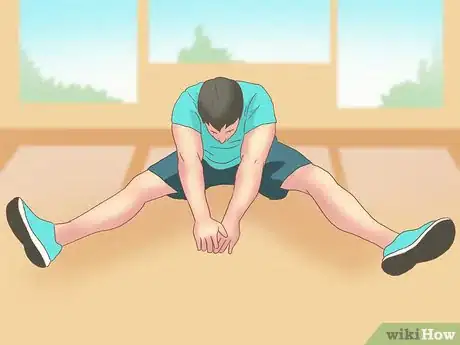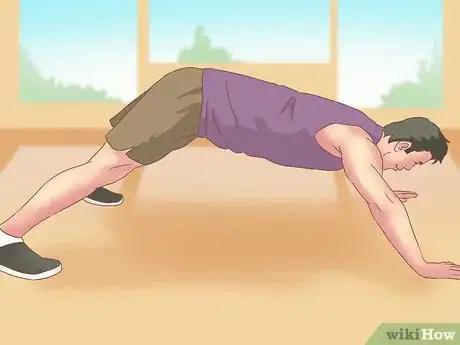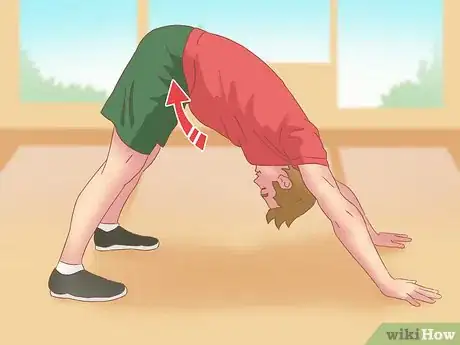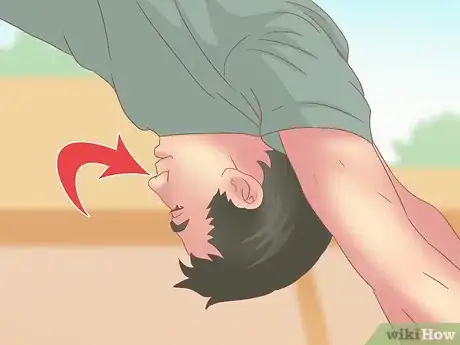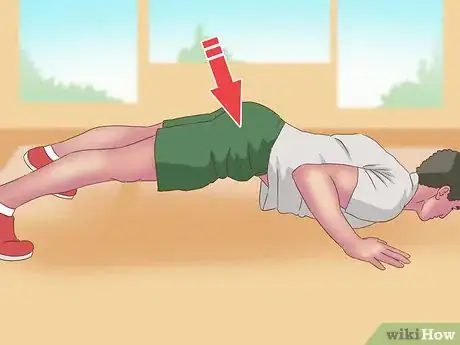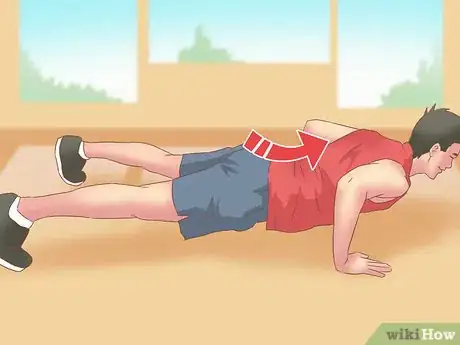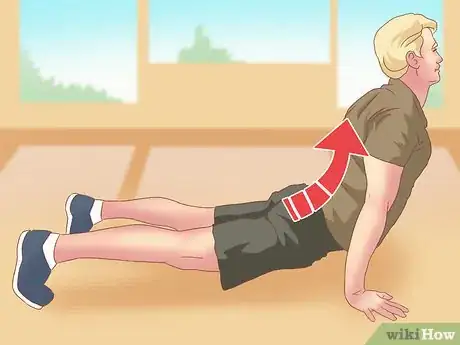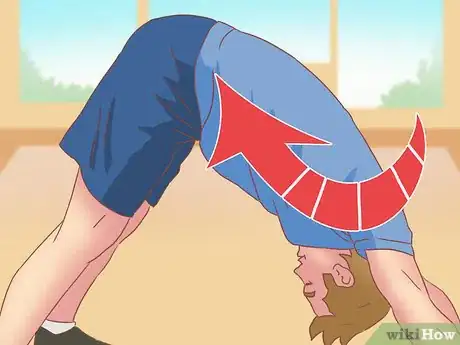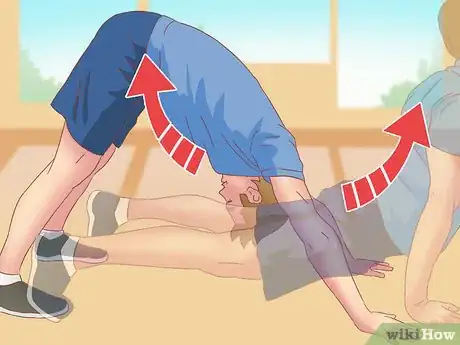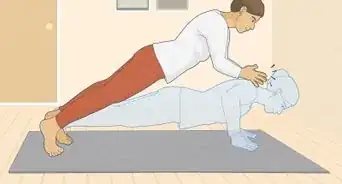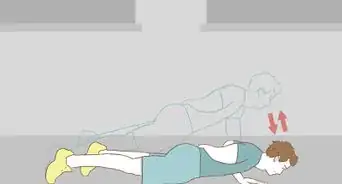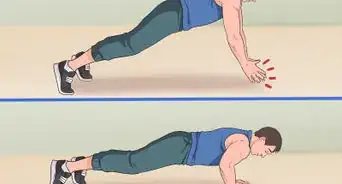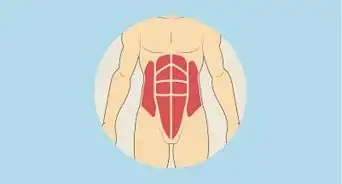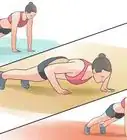This article was co-authored by Michele Dolan. Michele Dolan is a BCRPA certified Personal Trainer in British Columbia. She has been a personal trainer and fitness instructor since 2002.
This article has been viewed 146,751 times.
The Hindu push-up, also known as dand or downward facing dog, is a complex move made up of multiple parts. It engages your entire body and is a rather intense version of a push-up. Similar to a regular push-up, the Hindu push-up strengthens your triceps, pectorals, and deltoids, but with the added benefit of strengthening your hamstrings, abdomen, back muscles, and glutes. Master the Hindu push-up by learning how to do each part individually. Once you master each part, you will be able to move through the motions seamlessly.
Steps
Positioning Yourself in the Starting Position
-
1Stretch before doing the Hindu push-up. To prevent injury, you should stretch before doing this exercise. Stretching will loosen your muscles and enable you to do this exercise more fluidly.
- Start stretching by standing up, with your feet spread shoulder length apart. Then, bend to touch your toes on each foot, and hold for 10 seconds.
- Alternatively, you can stretch sitting down. Sit on the floor with your legs spread, similar to a V position. Reach for your toes on the left foot, right foot, and then reach as far as you can in the middle, and hold for 10 seconds.
-
2Get into a starting push-up position. To start the Hindu push-up, get into a normal, starting push-up position. With your knees bent and touching the ground, place your hands on the ground directly under your shoulders (your arms should be straight). Then, slowly remove your knees from the floor and dig your toes into the ground to stabilize the lower half of your body. You should be in a high plank position.[1]Advertisement
-
3Raise your backside into the air. Once you are in the starting push-up position, begin to raise your backside up into the air. As you raise your backside into the air, keep your arms, legs, and back straight. At this point, your eyes should be looking at your feet. In this position, you will look like an upside down V.
- This V position is essentially the starting position, and you will return to this position after you complete each push-up.
Beginning the Push-up
-
1Inhale deeply. Before you begin the next movements of the push-up, remember to breathe in deeply through your nose.[4]
-
2Bend your elbows and lower your chest. While breathing in, begin to bend your elbows outward and lower your chest to the ground. Your backside should be more level to the ground, but still pointing slightly upward at this point. You will feel as if you are in a flexed push-up position with your backside slightly pointed upward.
-
3Arch your lower and upper back. As your chest gets lower to the ground, in a scooping motion, scoop your head upward while arching your lower and upper back. Exhale through your mouth as you do this motion. At this point, you are essentially at the “bottom” of the push-up.
Ending the Push-up
-
1Straighten your arms and look up. After scooping your head in a round, upward motion and arching your back, straighten your arms, lift your torso, and look upwards.[5] Your hips should be down towards the floor, but not touching the floor.
- At this point, you have pretty much completed the Hindu push-up, but you still need to return to the starting position.
-
2Return to the starting position. To return to the starting position, lower your torso and lift your hips to return to the V position; use your abs and gluteus maximus, i.e., your butt muscles, to bring your backside up into the air. As you push back to the starting position, inhale deeply through your nose, and exhale through your mouth as you reach the V position.[6]
- To return to the starting position, you do not need to reverse back through the sweeping, arching motion. Simply push back into the starting position.
-
3Repeat. If you are a beginner, it is recommended that you do as many push-ups or repetitions as you are able to, for example, 3 or 5 repetitions is fine. If you need to rest during the exercise, take a break in the starting V position. As you become better you can add more sets and repetitions. For example, you can do 2 sets of 3 repetitions or push-ups. If you are more advanced, you can do more sets with more repetitions. For example, 3 sets with 8 to 10 push-ups or repetitions.[7]
- These push-ups should be done seamlessly in a sweeping motion without delay between each part.
Community Q&A
-
QuestionI'm a Muslim and I don't want any push-ups invented by Christians or Hindus who are all infidels. Can you describe Islamic push-up methods?
 Community AnswerI myself am Muslim and want you to know that there are no such things as Islamic, Hindu, or Christian push-ups. These push-ups can also be called "seal push-ups" or "dands." They were not invented by Hindus - this is just the name they were given. You can do these, there is nothing wrong with them in the Islamic view.
Community AnswerI myself am Muslim and want you to know that there are no such things as Islamic, Hindu, or Christian push-ups. These push-ups can also be called "seal push-ups" or "dands." They were not invented by Hindus - this is just the name they were given. You can do these, there is nothing wrong with them in the Islamic view. -
QuestionWhat should I do to stop pain in my shoulders while doing it?
 Community AnswerIce it, relax for a while, and consult your local physician. They know what's best, don't always trust the internet.
Community AnswerIce it, relax for a while, and consult your local physician. They know what's best, don't always trust the internet.
Warnings
- Some common errors are letting your knees and hips touch the ground, and going straight up and down and not in an arch-like motion.⧼thumbs_response⧽
References
- ↑ http://greatist.com/fitness/how-do-perfect-push
- ↑ http://www.mensxp.com/health/fitness/10238-how-to-do-hindu-push-ups.html
- ↑ http://www.mensxp.com/health/fitness/10238-how-to-do-hindu-push-ups.html
- ↑ http://www.womenshealthandfitness.com.au/fitness/workouts/1642-hindu-push-up
- ↑ http://www.spotebi.com/exercise-guide/hindu-push-ups/
- ↑ http://www.warriorpt.com/sample.htm
- ↑ http://www.mensxp.com/health/fitness/10238-how-to-do-hindu-push-ups.html
